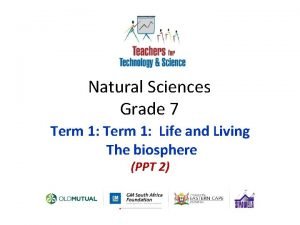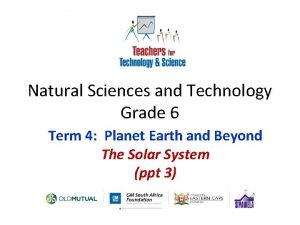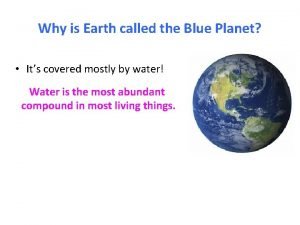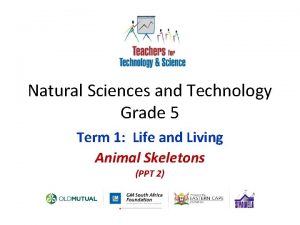Natural Sciences Grade 7 Term 4 Planet Earth





![Sandy shore ecosystems [1] • Land living animals [sand fleas – pic. 1 and Sandy shore ecosystems [1] • Land living animals [sand fleas – pic. 1 and](https://slidetodoc.com/presentation_image_h2/2583d13447bcec321ba78d6eb4d8ba4e/image-6.jpg)
![Sandy shore ecosystems [1] • Plough snails [pic. 3] and a variety of shellfish Sandy shore ecosystems [1] • Plough snails [pic. 3] and a variety of shellfish](https://slidetodoc.com/presentation_image_h2/2583d13447bcec321ba78d6eb4d8ba4e/image-7.jpg)
![Sandy shore ecosystems [2] • White mussels live in the wet sand they move Sandy shore ecosystems [2] • White mussels live in the wet sand they move](https://slidetodoc.com/presentation_image_h2/2583d13447bcec321ba78d6eb4d8ba4e/image-8.jpg)
![Sandy shore ecosystems [2] • Tiny creatures that survive from the bacteria, organic matter Sandy shore ecosystems [2] • Tiny creatures that survive from the bacteria, organic matter](https://slidetodoc.com/presentation_image_h2/2583d13447bcec321ba78d6eb4d8ba4e/image-9.jpg)
- Slides: 9

Natural Sciences Grade 7 Term 4: Planet Earth and Beyond Relationship of the Moon to the Earth (ppt 4)

Topic 2 Relationship of the Moon to the Earth Shoreline Ecosystems Natural Sciences - Grade 7

Shorelines • Tides move in and out two times daily and thus the shorelines are sometimes under water OR exposed to air. • Living creatures in the sea must live in cold temperatures. • The sea water along the west coast has a temperature of 6 -14ºC. • Tides that go out, can be very hot, because the intertidal zone [shoreline area that lies between the low tide line and the high tide line] is exposed to the blazing sun. Natural Sciences - Grade 7

Shorelines • Living things do not dry out, they survive as follows: - Shellfish clamp down tightly on rocks. - Snails burrow down into the sand. • The sea brings plankton [rich food for living organisms in shoreline ecosystems] and organic matter in with every tide. • Plants grow fast in shallow water, because there is a lot of light. • Seaweed [e. g. kelp] is found on the shore after storm waters. Natural Sciences - Grade 7

Rocky shore ecosystems • Small snails and lichens grow here. • • • Water cover some rocks for a short time of every day. Shellfish and snails are the main animals. Seaweed grow around and in rocky pool. Other creatures and anemone live in the rock pools. Small crabs hide in the seaweed. Natural Sciences - Grade 7
![Sandy shore ecosystems 1 Land living animals sand fleas pic 1 and Sandy shore ecosystems [1] • Land living animals [sand fleas – pic. 1 and](https://slidetodoc.com/presentation_image_h2/2583d13447bcec321ba78d6eb4d8ba4e/image-6.jpg)
Sandy shore ecosystems [1] • Land living animals [sand fleas – pic. 1 and ghost crabs – pic. 2] are found in the upper beach area which is dryer. • The beach is later exposed to the air after the beach had been under water for a certain period. Natural Sciences - Grade 7
![Sandy shore ecosystems 1 Plough snails pic 3 and a variety of shellfish Sandy shore ecosystems [1] • Plough snails [pic. 3] and a variety of shellfish](https://slidetodoc.com/presentation_image_h2/2583d13447bcec321ba78d6eb4d8ba4e/image-7.jpg)
Sandy shore ecosystems [1] • Plough snails [pic. 3] and a variety of shellfish [pic. 4] are found further down where the beach is covered by seawater. • These plough snails appear from the sand during high tide so that they can be washed up ashore by the waves in order to feed on decayed flesh particles on the sand. • During low tide the plough snails burrow into the sand to ensure that they are not dried out. Natural Sciences - Grade 7
![Sandy shore ecosystems 2 White mussels live in the wet sand they move Sandy shore ecosystems [2] • White mussels live in the wet sand they move](https://slidetodoc.com/presentation_image_h2/2583d13447bcec321ba78d6eb4d8ba4e/image-8.jpg)
Sandy shore ecosystems [2] • White mussels live in the wet sand they move up and down as the tides change. [pic. 1] • They have siphons [two small tubes]. Water is sucked up through one siphon and filter out whatever is edible, while the other siphon is used to pump out the water. Natural Sciences - Grade 7
![Sandy shore ecosystems 2 Tiny creatures that survive from the bacteria organic matter Sandy shore ecosystems [2] • Tiny creatures that survive from the bacteria, organic matter](https://slidetodoc.com/presentation_image_h2/2583d13447bcec321ba78d6eb4d8ba4e/image-9.jpg)
Sandy shore ecosystems [2] • Tiny creatures that survive from the bacteria, organic matter and algae [pic. 4] live in the sand grains and they are eaten by the birds in the sandy shore ecosystem. • Kelp [pic. 2] and sand hoppers [pic. 3] hide below the material that the high tides and the strong waves wash up. • Living things must burrow into the sand in order to survive. Natural Sciences - Grade 7
 Natural science grade 7 term 1
Natural science grade 7 term 1 Planet earth and beyond grade 7
Planet earth and beyond grade 7 Natural science grade 7 term 3 lesson plans
Natural science grade 7 term 3 lesson plans Natural science grade 6 solar system
Natural science grade 6 solar system Natural science grade 6 term 3
Natural science grade 6 term 3 Human sciences tok
Human sciences tok Why is earth called the blue planet?
Why is earth called the blue planet? Technology grade 7 term 2 notes
Technology grade 7 term 2 notes Metals and non metals grade 5
Metals and non metals grade 5 Natural science grade 5
Natural science grade 5
















